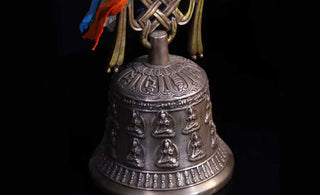
Tibetan ritual art holds a profound place within the rich tapestry of Tibetan culture and spirituality. In this exploration, we delve into the multifaceted dimensions of Tibetan ritual art, unraveling its historical, religious, cultural, and aesthetic significance. As we navigate through these aspects, we come to understand how Tibetan ritual art serves as a conduit for embracing harmony, weaving together the threads of tradition, symbolism, and the sacred.
1. Historical Roots and Evolution
Tibetan ritual art traces its origins to ancient times, deeply intertwined with the evolution of Tibetan Buddhism. The art form evolved as a means of conveying spiritual teachings and transmitting the wisdom of the Dharma visually. Over centuries, Tibetan artisans refined their techniques, resulting in a distinctive style that amalgamates indigenous influences with those from neighboring regions.
Examining the historical trajectory of Tibetan ritual art provides insights into the cultural and religious forces that shaped its development. From the early thangkas depicting Buddhist deities to the intricately crafted ritual objects, each artifact narrates a story of artistic evolution influenced by Tibetan history and the introduction of Buddhism from India.
The origins of Tibetan ritual art are deeply embedded in the annals of time, tracing back to the early propagation of Buddhism into the region. As Buddhism made its way from India to Tibet, it encountered the indigenous Bon religion, resulting in a syncretic blend of beliefs and practices. This fusion laid the foundation for a distinctive Tibetan Buddhist culture, and the artistic expression became a powerful means of conveying the profound spiritual teachings of the Dharma.
Thangkas, the traditional painted or embroidered scrolls, emerged as early forms of Tibetan ritual art. These vivid depictions of Buddhist deities, mandalas, and cosmic landscapes served not only as aids for meditation but also as tools for transmitting the wisdom of the Dharma to a largely non-literate population. The evolution of thangkas reflects the assimilation of Indian, Nepalese, and Central Asian artistic styles into a uniquely Tibetan aesthetic.
The Vajra Bell Ghanta, a bell with a vajra handle, represents the feminine principle and wisdom. The clear sound of the bell is believed to dispel ignorance and awaken sentient beings to the truth. The ghanta is adorned with intricate engravings and often features auspicious symbols, portraying the artistic finesse that Tibetan artisans brought to their craft.
In contrast, the Vajra Dorje, a thunderbolt or diamond scepter, symbolizes the masculine principle and compassion. It signifies indestructibility and the unyielding nature of enlightenment. Like the ghanta, the dorje is intricately crafted, often with detailed carvings that narrate stories from Buddhist scriptures.
2. Sacred Symbolism in Tibetan Ritual Art
Central to Tibetan ritual art is the rich tapestry of symbolism woven into every brushstroke and sculpted form. Mandalas, thangkas, and ritual implements are infused with layers of meaning, acting as visual metaphors for spiritual concepts. Understanding the symbolism enables practitioners to deepen their connection with the divine and navigate the intricate web of Tibetan Buddhist philosophy.
Exploring specific symbols such as the Dorje, the Kalachakra, and the Eight Auspicious Symbols reveals a complex system of representation. Each symbol serves as a portal to deeper understanding, guiding individuals on their spiritual journey and fostering a sense of unity with the cosmic order.
3. Ritual Practices and Their Artistic Expressions
Tibetan rituals are vibrant, multisensory experiences, and the art associated with these practices plays a crucial role in enhancing their efficacy. From the creation of intricate sand mandalas to the crafting of ritual masks and dance costumes, every artistic element is meticulously designed to facilitate a harmonious convergence of the spiritual and the aesthetic.
A detailed exploration of specific rituals, such as the Cham dance or the construction of sand mandalas, illuminates the symbiotic relationship between the ritual practitioners and the art they create. The performative nature of Tibetan rituals, coupled with the visual allure of associated art, creates a holistic experience that transcends the boundaries between the earthly and the divine.
4. Cultural Continuity and Adaptation
As Tibetan communities navigate the currents of modernity, the continuity of ritual art faces both challenges and opportunities. The preservation of traditional techniques and the adaptation of artistic forms to contemporary contexts reflect the dynamic nature of Tibetan ritual art. Artists and communities engage in a delicate dance between honoring centuries-old traditions and expressing the evolving spiritual and cultural ethos.
Exploring how Tibetan ritual art adapts to changing circumstances provides a glimpse into the resilience of Tibetan culture. Through initiatives that blend traditional aesthetics with modern sensibilities, artists strive to ensure that the essence of Tibetan ritual art continues to resonate with new generations while retaining its authenticity.
5. The Aesthetics of Transcendence
Beyond its religious and cultural dimensions, Tibetan ritual art possesses an intrinsic aesthetic quality that transcends its utilitarian purpose. The exquisite craftsmanship, vibrant colors, and attention to detail elevate these artistic expressions to the realm of the sublime. Tibetan ritual art invites viewers to contemplate the intersection of beauty and spirituality, fostering an appreciation for the transcendent aspects of the human experience.
By examining the aesthetic dimensions of Tibetan ritual art, we uncover the transformative power of beauty in the pursuit of harmony. Whether through the serenity of a thangka or the dynamic energy of ritual dance, Tibetan ritual art serves as a bridge between the mundane and the divine, inviting individuals to immerse themselves in the beauty of the sacred.
In conclusion, embracing harmony with Tibetan ritual art entails a holistic exploration of its historical roots, sacred symbolism, ritual practices, cultural adaptation, and aesthetic dimensions. In traversing these facets, we come to appreciate Tibetan ritual art not merely as a visual expression but as a living tradition that weaves together the spiritual and the cultural, inviting individuals to connect with the profound harmony embedded within its artistic tapestry.

Vajra Bell Ghanta Vajra Dorje Bronze Tibetan Ritual
























